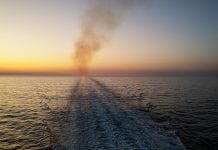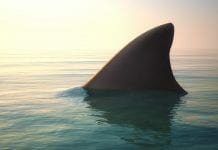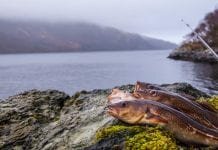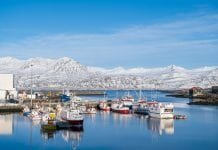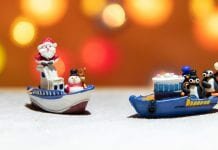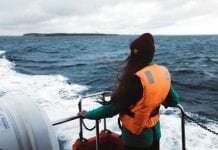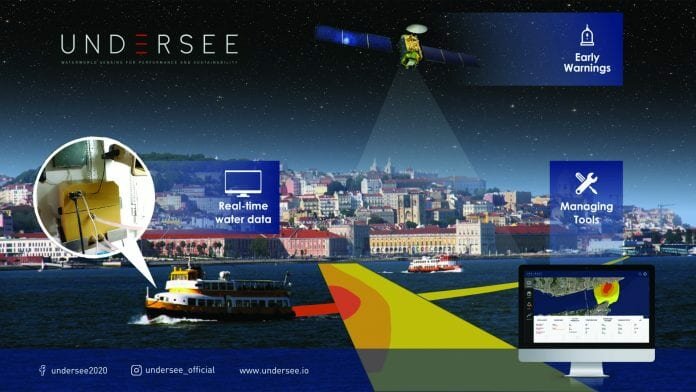
UNDERSEE offers innovative water quality data monitoring and forecasting technology, enabling aquaculture operators to avert the spread of disease and harmful algae bloom.
Aquaculture is one of the more sustainable means of meeting the world’s demand for high quality protein in the face of a rapidly expanding global population, offering a high volume of product with a superior economic yield for farmers. Europe has long been at the forefront of safety standards when it comes to aquaculture, with over 25% of the seafood consumed in the EU coming from the sector. The task of improving quality, however, does not end with the opportunity to improve methods; as waters are still at risk of threats which will need to be prevented or corrected. This means that aquaculture farmers still face many challenges, from reducing production costs and labour to losing stock to diseases, harmful algae bloom and water quality contamination.
Precision aquaculture could help to overcome these challenges. Precision aquaculture is the process of improving the methods deployed in aquaculture through the use of emerging technologies in order to maximise operations, help in decision making, reduce labour and monitor the health and status of fish. Sustainable aquaculture is necessary because fisheries alone will not meet the growing global demand for seafood. Aquaculture can also help reduce pressure on wild fish stocks.
The history of UNDERSEE: water quality monitoring and data visualisation
UNDERSEE was launched in 2016 as an arm of the company Matereospace, before progressing into its own fully fledged startup company; with the overarching goal of driving the push towards greater use of technology in the aquaculture sector. Launched under the European Space Agency Business Incubation Centre in Portugal (ESA BIC Portugal), the project developed a multisensory fusion system for water quality monitoring.
Given the lack of both available water quality data and the absence of a reliable system through which to collect such data, the project’s first two years saw the construction of a first prototype for in situ data acquisition system – UNDERSEE_water – and a cloud dashboard for data visualisation, the UNDERSEE_cloud. UNDERSEE uses both commercial off-the-shelf and open innovation technologies; and its systems are applicable to boats and aquaculture cages.
UNDERSEE’s plug-and-play acquisition system provides real time data to the UNDERSEE_cloud system, which provides real time assessment of critical variables (such as pH, temperature, dissolved oxygen or salinity levels) and automated alarms in case of anomaly.
About 15% of the surface water bodies in the EU are in an unknown ecological state and about 40% in an unknown chemical state. In aquaculture, due to the lack of a real time water quality monitoring solution, the economic losses related to the appearance of harmful algae bloom have been estimated at €919m per year throughout the EU. By 2025, the United Nations (UN) aims to prevent and reduce marine pollution of all kinds, in particular from land-based activities; including marine debris and nutrient pollution.
UNDERSEE_water is a small and easy to install device, equipped with state of the art water quality sensor technology which can be used to collect data from water bodies in real time. The core water parameters measured using the sensor are:
- Water temperature;
- Acidity (pH);
- Levels of dissolved oxygen;
- Oxidation-reduction potential;
- Conductivity and salinity;
- Turbidity; and
- Levels of chlorophyll-a.
The dashboard, UNDERSEE_cloud, allows users easy access to several parameters and features, such as:
- Checking water parameters in real time;
- Defining alerts, fault notifications and data insights;
- Reviewing historical water quality data;
- Viewing dynamic water data maps;
- Validation and calibration of both water space data and forecast models against data in situ; and
- Automated decision making tools based on early warnings.
All these features help the end user to save their fish from sudden quality changes in the water without dealing with excessive maintenance of water quality sensors and monitoring systems. This will increase animal welfare; as well as mitigating the environmental impact on the surrounding ecosystems of problems such as diseases and harmful algae bloom.
Marine environments continue to be severely under-sampled; and environmental water monitoring programmes suffer from unsustainable funding in the long term. UNDERSEE is developing a scalable solution and a sustainable business model in the fields of water quality monitoring and conducting environmental impact assessments in rivers, lakes and oceans; and is committed to expanding knowledge about marine environments by providing simple access to comprehensive, real time water quality data.
Business development and funding
UNDERSEE launched under the European Space Agency’s BIC Portugal programme, which enables entrepreneurs to receive both business and technical support to set up their business using space technology for nonspace industrial and commercial uses; and during two years of the programme the company was able to develop its first minimum viable product and build its first business case. UNDERSEE also recently completed an Atlantic Area Kick-start Activity, a six-month programme using the framework of a European Space Agency (ESA) Business Application.
The objectives of this Kick-start activity were to explore the viability of new service and application concepts and consolidate the user landscape, including the derivation of user requirements. User needs and requirements were mapped; and the system and service architecture was defined according the feedback collected. The approach was tested with potential users and customers and UNDERSEE learned how to communicate the benefits of its service in a clearer and more structured way. The company has ongoing discussions and negotiations with the most important stakeholders in Europe in the field of water quality monitoring and data; and is planning a demonstration activity beginning in the first quarter of 2020 through the ESA’s Business Applications programme to implement in a real customer scenario the services tested through the Kick-start Activity.
Since the official launch of UNDERSEE in April of 2016 in the field of ESA BIC Portugal, the company has raised over €105,000 in European research grants for developing its technologies and the first value layer of its future service. UNDERSEE’s full service architecture is composed of the following value layers and correspondent technologies:
- Real time water quality data (in situ acquisition system);
- Managing tools (data fusion and web services); and
- Early warnings (predictive models).
Currently, the company has a fully functional solution for the first value layer, acquiring real time water quality data; and is starting to evaluate and test Earth observation data products and forecasting solutions to be integrated in the cloud platform. The full service architecture still requires ongoing hardware and software developments and appropriate project management regarding manufacturing, installation and logistics. The Kick-start Activity gave UNDERSEE the necessary credibility to start building long term collaborations with governments, NGOs, research centres, foundations, innovation clusters and industry. Some of these institutions demonstrated interest in co-funding a demonstration project under an ESA Business Applications programme. The full implementation of the service architecture with the three value proposition layers already mentioned is only possible with funding and collaboration with the right partners: ‘We need to build long term relationships with Research Centres towards value co-creation, if we want to be successful.’
UNDERSEE needs to prioritise its business and service development; and any technology transfer must be effective. A good example of this approach is the KETmaritime Interreg Atlantic Area: a technology transfer programme regarding Key Enabling Technologies (KET) in the field of maritime applications. In the field of this programme, the Iberian Nanotechnology Laboratory is currently working with the UNDERSEE’s team to implement state of the art technologies to increase lifetime of in situ sensors regarding biofouling.
Commercial rollout and the consumer experience
UNDERSEE’s service targets are environmental monitoring and aquaculture monitoring segments. UNDERSEE’s solution allows users to monitor and forecast water quality changes in rivers, lakes or oceans; without dealing with sensor maintenance. UNDERSEE provides an end-to-end service with an integrated offering of water quality data monitoring hardware, software, installation, maintenance and customer support; based on a Connected Product-as-a-Service model where customers subscribe for the usage of the product (paying a data-based fee) and automated decision making tools.
For the aquaculture monitoring segment, the service is addressed to open-net pen aquaculture. Shellfish producers or fish farmers can use the UNDERSEE’s solution to prevent production losses and optimise fish feeding and growth. Among other features, users will be able to access predictions about future levels of dissolved oxygen, with the option to receive early warnings via SMS or email about possible harmful algae bloom threats or severe oxygen depletion events. Users will have easy access to a daily water data management tool, which is intended to supply the site manager with relevant and timely information, to make informed management decisions based on actionable data.
During its Kick-start Activity, UNDERSEE closed its first data monitoring campaign contract, providing water quality monitoring in Lisbon’s Tagus river. This project is funded by MyCOAST – Coordinated Atlantic Coastal Operational Oceanographic Observatory (EU Interreg Atlantic Area). In addition to acting as a real world use case for the implementation of the solutions offered by UNDERSEE in a real customer scenario, this achievement will enable the company to attract much more user confidence and visibility to future customers. An UNDERSEE water quality data monitoring system will be installed in a passenger boat which navigates in a daily basis between the two banks of the Tagus. The boat will collect water quality data to be stored in UNDERSEE’s cloud data facility for 18 months to validate and confirm numerical models developed by the customer.
In recognition of the importance of acceleration programmes to prepare the company before the commercialisation phase, in the fourth quarter of 2018 UNDERSEE joined the BLUEBIO VALUE programme in Lisbon, an acceleration programme created in partnership by Oceano Azul Foundation and Calouste Gulbenkian Foundation. The programme has four objectives:
- To feed the world’s growing population;
- Reducing pollutant emissions;
- Addressing resource scarcity and reduce the use of plastics; and
- Developing nutrition solutions for the growing elderly population.
UNDERSEE’s participation in the BLUEBIO VALUE programme enabled the company to gain an understanding how important the solution is for sustainable aquaculture.
After completing of the BLUEBIO VALUE acceleration programme, UNDERSEE was accepted into the Katapult Ocean Accelerator, which helps build and scale profitable businesses which have a positive impact on the marine environment. UNDERSEE was selected from the 500 candidate startups around the world to be one of 11 companies to participate in the first accelerator batch, which took place in Oslo from 14 January to 8 April 2019.
One of the biggest achievements of this programme was the opportunities it offered for engagement with research centres, NGOs and fish farmers among other stakeholders in Norway. UNDERSEE is now planning its first pilot in a precommercialisation phase in the field of aquaculture monitoring with Grieg Seafood, one of the world’s largest aquaculture companies, based in Norway. The full service architecture still requires ongoing developments so the commercialisation phase will start after the completion of the demonstration activity project starting in the first quarter of 2020 in the field of ESA Business Applications.
On the road to success
In 2017, UNDERSEE was awarded with the Blue Revelation Diploma for Innovation at the Excellens Mare Awards promoted by PwC. The awards recognise innovative projects with potential for the future development of sea activities. In 2018, UNDERSEE joined the Vodafone Power Lab programme to receive business mentoring and 3G connectivity support; won the first prize of the BLUEBIO VALUE competition with two other startups; attracted an impact investment of $150,000 (€134,932.36) from Katapult Ocean, a private investment entity, which invests in startups with a positive impact in the oceans.
In 2019, UNDERSEE was nominated for the Seafood Innovation Prize during the North Atlantic Seafood Forum event in Bergen, Norway, the world’s largest seafood business event; and received support funding for research and development from KETmaritime Interreg Atlantic Area. UNDERSEE promoted its project at the Ocean Business Southampton 2019 event and European Maritime Day 2019, held in Lisbon; where UNDERSEE CEO Jorge Alexandre Vieira participated in the session: ‘EU bioeconomy strategy: towards a more circular and innovative blue bioeconomy’. In September 2019, UNDERSEE’s team presented its project along with 12 other innovators on the main stage of the Aquaculture Innovation Summit in London.
At the end of 2018, UNDERSEE reached one of its most important achievements to date: engaging with an early adopter of the service (under the MyCOAST project), which represents the beginning of a long term relationship for future projects and value cocreation. This contract with IST – Técnico Lisboa at the University of Lisbon is a great opportunity to test the reliability of UNDERSEE’s water quality monitoring system in a real water environment and gauge customer feedback regarding potential improvements to both the actual data visualisation features and satellite data fusion.
Challenges to come
Aquaculture producers must increase their levels of fish production by 50% by 2030 to meet the increasing demand occasioned by population growth. Even if an algae bloom event is not toxic, an early warning is still valuable to prevent production losses and optimise fish feeding in an aquaculture institution. To overcome these challenges while maintaining a competitive hold on the market, aquaculture companies typically uphold their operational decisions based on reliable water quality data and dynamics of the water. But the traditional water monitoring technology requires a lot of human intervention regarding sensors operations and maintenance which normally leads to low quality of data sets since aquaculture companies are focused on the production instead of water quality monitoring tasks.
Because UNDERSEE allows users to monitor and predict water quality changes in rivers, lakes or oceans, without dealing with sensor maintenance, fish farmers are able to use it as a daily management tool to prevent production losses and the spread of harmful algae bloom, while optimising fish feeding and growth.
UNDERSEE is the first commercial solution on the market for water quality data integration (this includes in situ, space data and numerical models) with maintenance free sensors and a databased fee subscription system. With this model, UNDERSEE fills a clear gap in the market regarding a new service for water quality monitoring based on actionable data; which enables moving from reactive decision making to a preventive decision making approach in the daily management of aquaculture production. This reduces operation costs due to production optimisation based on real time monitoring of water quality data; and losses will be prevented by innovative forecasting tools.
A service like no other
UNDERSEE’s unique selling point is the fact that the service is only paid for after data is received. The integration of in situ data, satellite data and numerical modelling for water quality forecasting is far beyond any other commercial solution currently available on the market.
The UNDERSEE_water device is a flow-through system similar to those used in Ships of Opportunity programmes, wherein ships are equipped with flow-through systems (usually called ‘Ferryboxes’). It consists of a bypass circuit of water to the boat main hydraulic system, where all the sensors are situated. These systems are usually operated by research centres within the framework of funding programmes. UNDERSEE is currently launching the first Portuguese FerryBox system through the MyCoast project in Lisbon: water quality data collected from a FerryBox passenger boat will be made publicly available through the EMODnet European Central Portal. UNDERSEE will also prepare its own flow-through water system for implementation directly on aquaculture cages, in order to collect water data at depths between 5m and 30m; which will be an added value to the aquaculture monitoring service.
Concerns over microplastics
Microplastics can be found everywhere on the planet and are impossible to filter out of the water, meaning they eventually end up in our food chain – in fish and consequentially in humans too. UNDERSEE is very concerned about this problem and recently became a member of the international network Plastic Monitoring in Waters (PlaMoWa) Europe, a research and development network of private enterprises and research institutions. The network aims to develop methods and solutions for the secure, affordable and transparent monitoring of plastic in wastewater streams and surface water. The network’s overarching mission is the implementation of plastic free wastewater discharge in surface water, for example during heavy rain events; at the same time, the network aims to identify and reduce plastics directly at their original source.
The quality of the wastewater as well as the condition of the surface water will be continuously monitored. The network’s vision and aims support the detailed implementation of the Marine Strategy Framework Directive (MSFD) and provide solutions for committed stakeholders. To date, only a limited number of the required technologies are available. The international collaboration with European partners enhances and promotes understanding of the implementation of the MSFD.
The international development community will embrace innovative developments for performing tasks in adherence with the MSFD in the EU. Jorge Alexandre Vieira of UNDERSEE will take over the role as the international coordinator of PlaMoWa network and hopes to contribute to mitigating the global problem of plastic pollution in water. UNDERSEE is also planning to integrate a microplastic monitoring system in future iterations of its FerryBox, to monitor the concentration of microplastics along shipping routes, following the example of Volvo Ocean Race scientific programmes. UNDERSEE also intends to install the system in sailing boats, because they navigate in areas that commercial vessels do not go; meaning they can provide in situ data from very remote areas on the ocean.
In 2018, UNDERSEE integrated a scientific project with two Portuguese research centres: the Centre for Environmental and Marine Studies at the University of Aveiro (CESAM) and the Interdisciplinary Centre of Marine and Environmental Research at the University of Porto (CIIMAR). The project, titled ‘MicroPlasTox – microplastics in the marine environment: estimation and assessment of their ecotoxicological effects’, is funded by the Foundation for Science and Technology (FCT); and aims to address the identified knowledge gaps on the existence of protocols and methodologies for microplastics sampling and quantification and the existence of ecotoxicological data using representative key species.
Data obtained through the project will be made available through an online repository and, based on the experimental results, the information will be used to develop a set of protocols for analytical and ecotoxicological assessments; which will include quality assurance and control recommendations and practices in both Portuguese and English. UNDERSEE’s brief in this project is to collect microplastics samples from marine environments in Portugal up to 50m deep, using a proprietary and adapted Remotely Operated Underwater Vehicle (ROV) carrying an innovative microplastics sampling net.
Jorge Vieira
Undersee
+351 239 160 318


